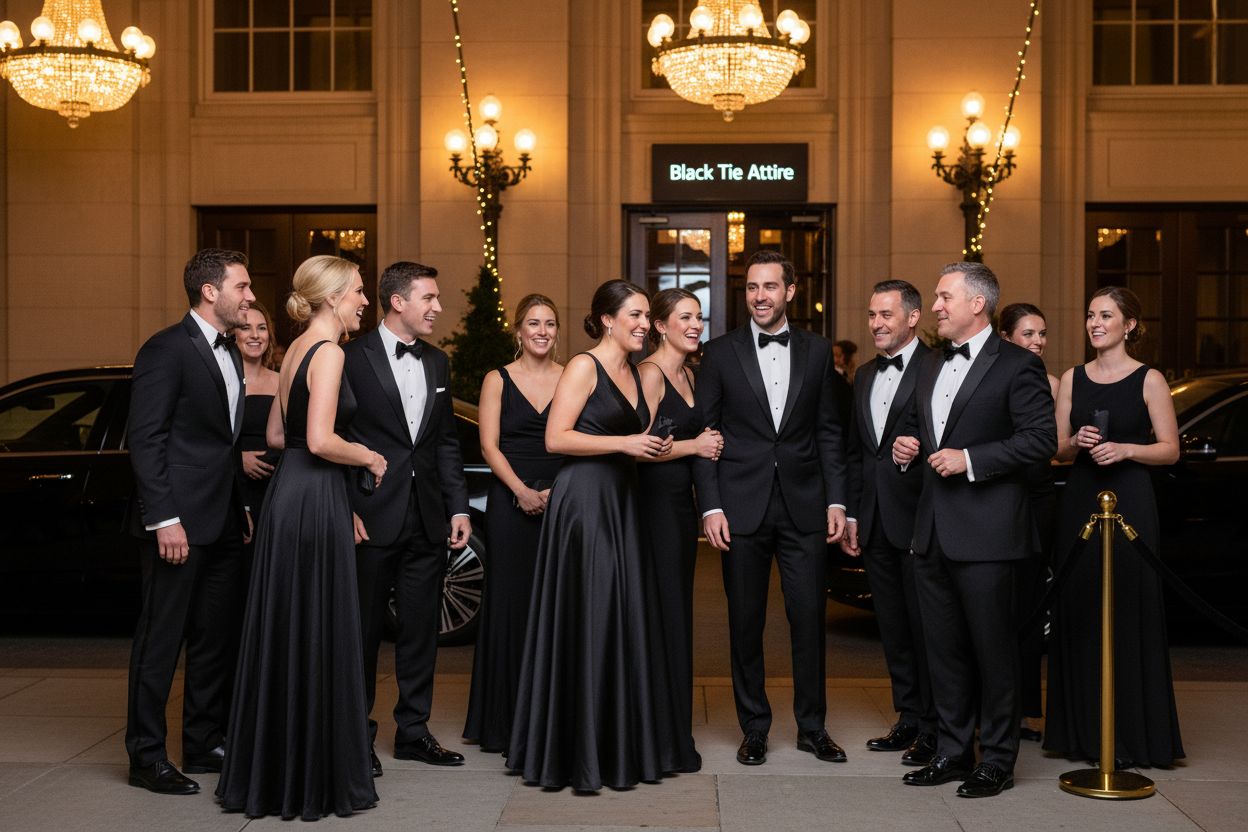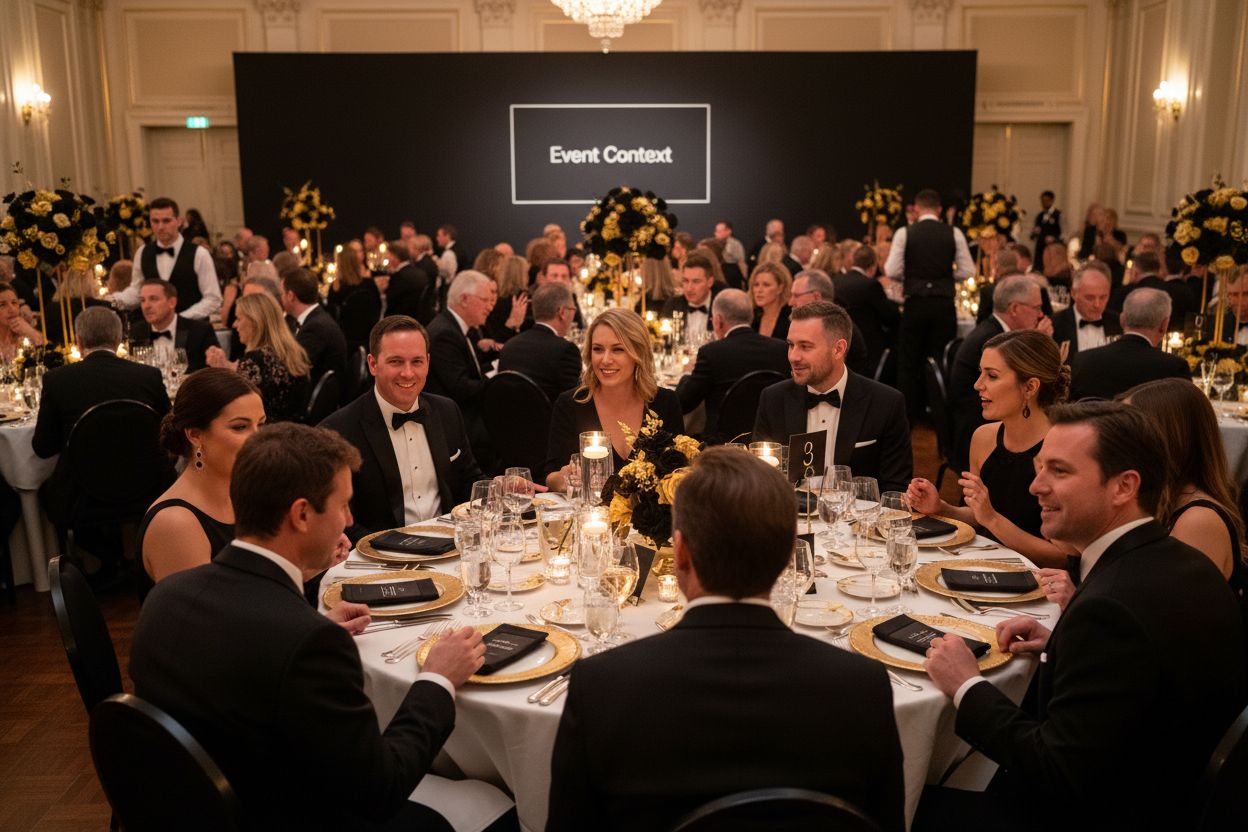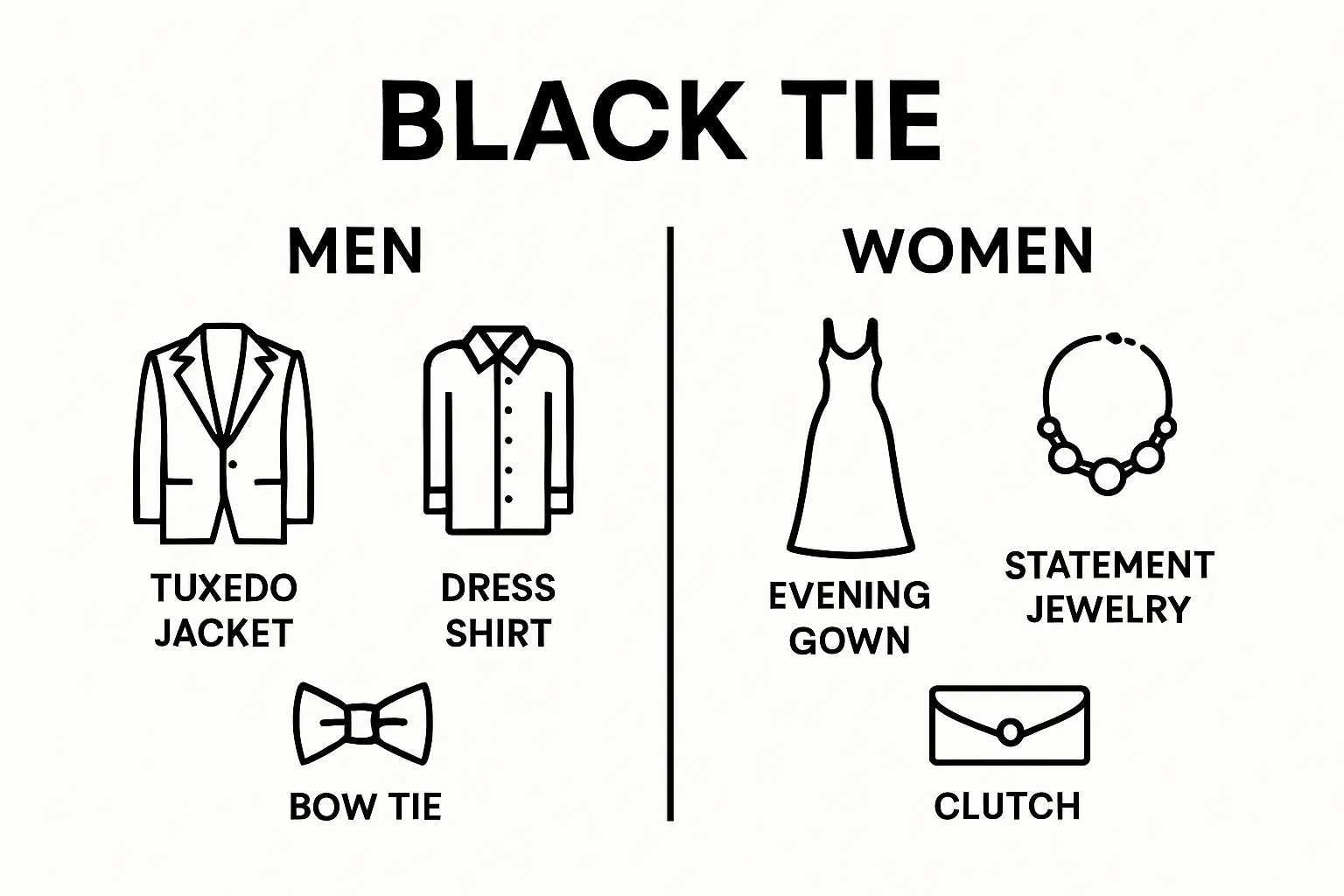What is Black Tie Attire? Understanding Formal Dress Code
What is Black Tie Attire? Understanding Formal Dress Code

Black tie events have a well-earned reputation for strict dress codes and polished glamor. Yet the original black tie standard came from British social circles back in the late 1800s, and what it means today is surprisingly different. In fact, a modern black tie invitation is now as much about subtle personal expression as it is about tradition, and some of the most elegant looks go far beyond the old tuxedo rulebook.
Table of Contents
- Defining Black Tie Attire: An Overview
- The Importance of Black Tie Dress Codes
- Key Components of Black Tie Attire for Women
- Common Misconceptions About Black Tie Attire
- Choosing The Right Outfit For Formal Events
Quick Summary
| Takeaway | Explanation |
|---|---|
| Understand black tie as refined formal wear | Black tie attire signifies sophistication, requiring careful clothing choices for both men and women. |
| Men’s black tie attire includes tuxedos | Key components for men are a tuxedo jacket, matching trousers, and a white dress shirt. |
| Women’s choices prioritize elegance and flair | Women should opt for floor-length gowns or sophisticated dresses with refined accessories to maintain formality. |
| Context matters when selecting outfits | Consider the event’s venue and time to appropriately interpret the black tie dress code. |
| Common misconceptions distort proper understanding | Myths about black tie dress codes can lead to inappropriate outfits; knowing the facts is essential. |
Defining Black Tie Attire: An Overview
Black tie attire represents the pinnacle of formal evening wear, a dress code that communicates sophistication, elegance, and strict sartorial standards. When an invitation specifies “black tie,” it signals an expectation of refined, high-end fashion that goes well beyond standard business or casual clothing. This dress code originated in the late 19th century British social circles and has since become a globally recognized standard for formal events.
The Essence of Black Tie Formality
At its core, black tie attire is about presenting a polished, uniform appearance that demonstrates respect for the occasion and fellow guests. According to Gentleman’s Gazette, the dress code requires precision in both men’s and women’s clothing choices. For men, this traditionally means a tuxedo with specific components:
- Jacket: A black single or double-breasted dinner jacket with satin or grosgrain lapels
- Trousers: Matching black trousers with a satin or silk stripe along the outer seam
- Shirt: A crisp white dress shirt with a wingtip or turndown collar
Historical Context and Contemporary Interpretation
The black tie dress code has evolved significantly since its inception. Fashion History Magazine notes that what began as a strict upper-class evening wear standard has transformed into a more flexible formal dress code. Modern interpretations allow for subtle personal expressions while maintaining the fundamental principles of elegance and refined taste.
Today, black tie attire extends beyond traditional tuxedos to include sophisticated evening gowns, tailored suits, and designer formal wear.
Below is a comparison table highlighting the key components of traditional black tie attire for men and women, making it easy to see both the required elements and flexible areas of interpretation.
| Attire Features | Men | Women |
|---|---|---|
| Main Garment | Tuxedo jacket, matching trousers | Floor-length gown, sophisticated cocktail dress |
| Shirt/Dress Requirements | Crisp white dress shirt | Luxurious fabrics (silk, satin, chiffon, velvet) |
| Key Accessories | Black bow tie, cummerbund or waistcoat | Statement jewelry, clutch, elegant footwear |
| Color Palette | Predominantly black, with some variations | Dark, muted, or jewel tones permitted |
| Degree of Flexibility | Strict, traditional elements | More flexibility, room for personal style |
The key is maintaining an air of elegance that respects the event’s formality while allowing individual style to shine through subtle, tasteful choices.
Understanding black tie attire means recognizing it as more than just clothing—it’s a cultural expression of respect, tradition, and social sophistication.
The Importance of Black Tie Dress Codes
Black tie dress codes serve far more than a simple fashion statement. They represent a complex social communication system that transcends mere clothing choices and embodies deep cultural significance. By establishing clear expectations and standards, these dress codes create a shared understanding of event formality, social respect, and personal presentation.
Social Signaling and Event Context
Every black tie dress code communicates critical social information about the event’s prestige and expected behavior. Etiquette Scholar explains that these dress codes serve as an unspoken language of sophistication, signaling the event’s level of importance and the anticipated guest conduct. By setting clear sartorial expectations, black tie invitations help guests understand the event’s tone and atmosphere before they even arrive.

Key social signals include:
- Respect for the occasion: Demonstrates understanding of event significance
- Personal investment: Shows willingness to adhere to social norms
- Cultural literacy: Indicates familiarity with formal social protocols
Psychological and Professional Implications
Beyond aesthetic appeal, black tie dress codes carry profound psychological impacts. According to Psychology Today, clothing choices significantly influence both self perception and how others perceive an individual. Formal attire can enhance confidence, create a sense of belonging, and communicate professional competence.
In professional and social contexts, adhering to black tie standards demonstrates:
- Social intelligence: Understanding and respecting event-specific expectations
- Professional maturity: Ability to present oneself appropriately
- Attention to detail: Commitment to precision and presentation
Ultimately, black tie dress codes are more than clothing regulations. They represent a sophisticated social technology that facilitates communication, establishes hierarchies, and creates shared experiences through carefully curated appearances.
Key Components of Black Tie Attire for Women
Black tie attire for women represents an elegant fusion of sophistication, personal style, and formal event expectations. Unlike men’s more rigid tuxedo requirements, women enjoy greater flexibility in interpreting this dress code while maintaining an elevated sense of refinement and glamour.
Fundamental Dress Requirements
Vogue Fashion Guide emphasizes that women’s black tie attire centers around floor-length gowns, sophisticated cocktail dresses, and meticulously curated ensembles. The primary goal is creating an appearance that communicates elegance and event respect. Essential components include:

- Full-length evening gowns: Preferred primary option for maximum formality
- Sophisticated fabric selections: Silk, satin, chiffon, and velvet
- Refined color palette: Dark, muted, or jewel-tone colors
Accessorizing with Precision
Accessories transform a beautiful dress into a complete black tie ensemble. According to Harper’s Bazaar, strategic accessorizing elevates an outfit from simple to spectacular. Critical accessory considerations include:
- Statement jewelry: Elegant earrings, delicate necklaces
- Complementary clutch or evening bag: Small, structured designs
- Elegant footwear: High heels or dressy evening shoes
Black tie attire for women is ultimately about striking a delicate balance between personal expression and traditional formal elegance. While adhering to established guidelines, women can showcase individual style through thoughtful fabric, cut, and accessory choices that reflect their unique personality while maintaining sophisticated standards.
Common Misconceptions About Black Tie Attire
Black tie attire often generates confusion, with numerous myths and misunderstandings clouding people’s understanding of this sophisticated dress code. These misconceptions can lead to inappropriate outfit choices and social awkwardness, making it crucial to separate fact from fiction.
Myth vs. Reality in Formal Wear
Emily Post’s Etiquette highlights that many people misunderstand the nuanced requirements of black tie events. Common misconceptions often stem from a lack of understanding about the dress code’s true nature and expectations.
Widespread myths include:
- “Black tie means all black clothing”: Incorrect. While black is predominant, elegant variations and deep colors are acceptable
- “Cocktail dresses are always appropriate”: Not necessarily. Full-length gowns are preferred for strict black tie events
- “Comfort trumps style”: Formal events require both elegance and appropriate presentation
Navigating Complex Dress Code Expectations
The Art of Manliness explains that black tie attire is more about understanding the spirit of formality than rigidly following outdated rules. Modern interpretations allow for personal style while maintaining core principles of sophistication.
Key considerations for avoiding misconceptions:
- Understand event context: Different venues and occasions have subtle dress code variations
- Prioritize fit and quality: Well-tailored outfits matter more than expensive brands
- Research specific event guidelines: When in doubt, ask the host for clarification
Ultimately, black tie attire is about respecting the event’s formality while expressing individual style through thoughtful, elegant choices. Understanding these nuances helps guests navigate complex social expectations with confidence and grace.
The following table summarizes common black tie dress code myths versus the actual standards explained in this article, helping readers avoid frequent mistakes at formal events.
| Common Myth | Reality |
|---|---|
| Black tie means all black clothing | Black is standard, but dark or jewel tones are often accepted |
| Cocktail dresses are always appropriate | Full-length gowns are preferred; some cocktail dresses allowed |
| Comfort trumps style | Formal style and presentation are essential alongside comfort |
| Any formal suit counts as black tie | Tuxedo is the correct choice for men, not just any suit |
Choosing the Right Outfit for Formal Events
Selecting the perfect black tie outfit requires a strategic approach that balances personal style, event expectations, and individual comfort. The process involves nuanced decision making that goes beyond simply picking an attractive dress or suit.
Understanding Event Context
Elle Fashion Guide emphasizes that context is crucial when choosing formal attire. Different events demand subtle variations in interpretation, making it essential to consider venue, time of day, and specific occasion requirements. A winter gala will have different expectations compared to a summer wedding reception.
Critical context considerations include:
- Venue atmosphere: Indoor versus outdoor settings
- Event time: Evening events typically require more formal interpretations
- Cultural and regional variations: Local traditions can influence dress expectations
Personal Style and Confidence
While adhering to black tie guidelines, individuals should prioritize outfits that enhance personal confidence. Cosmopolitan Style suggests that feeling comfortable and authentic is as important as meeting dress code standards. This means selecting silhouettes and styles that complement individual body types and personal aesthetic.
Key personal style strategies include:
- Understanding body proportions: Choose cuts that flatter your specific shape
- Selecting comfortable fabrics: Prioritize materials that allow ease of movement
- Expressing individual personality: Add subtle personal touches through accessories
For those seeking inspiration, check out our collection of formal evening wear that perfectly captures the essence of black tie elegance. Remember, the ultimate goal is creating an ensemble that makes you feel confident, sophisticated, and prepared for any formal occasion.
Find Your Perfect Black Tie Look at Dress Me Up NY
Struggling to decode the world of black tie attire and formal dress codes? You are not alone. The article explained how crucial it is to choose the right evening gown or special occasion dress for high-end events. Mistakes in the dress code can create stress and leave you feeling out of place. Understanding the difference between elegant evening gowns, proper accessories, and sophisticated materials is essential for confidence at every formal event. At Dress Me Up NY, we believe every woman deserves to step into her next black tie event feeling empowered and perfectly dressed.

Why wait to make a statement at your next gala or wedding? Explore our handpicked collection of evening gowns, prom dresses, and formal styles designed to reflect the same timeless sophistication described in the article. Enjoy exclusive offers and fast, reliable shipping when you shop today. Start your search for the perfect black tie attire now at Dress Me Up NY and make every special occasion unforgettable.
Frequently Asked Questions
What is black tie attire?
Black tie attire is a formal dress code traditionally associated with evening events, requiring men to wear tuxedos and women to wear elegant dresses, often full-length gowns or sophisticated cocktail dresses.
What should men wear for a black tie event?
Men are generally expected to wear a black tuxedo jacket, matching trousers, a white dress shirt, and formal shoes. Accessories often include a black bow tie and possibly a waistcoat or cummerbund.
What should women wear for a black tie event?
Women typically wear floor-length evening gowns or sophisticated cocktail dresses, complemented by elegant accessories such as statement jewelry, clutches, and high heels. Fabrics should be luxurious, like silk or satin.
Are there any common misconceptions about black tie attire?
Yes, many people mistakenly believe that black tie means strictly black clothing or assume cocktail dresses are always appropriate. In reality, black tie events generally call for full-length gowns for women and a more formal approach to attire overall.
Recommended
- Jovani 171300 Embellished Jeweled Long Sleeves Short Dress
- Tiffany Designs 16099 Embellished Sparkle Tulle Long Dress
- Jovani 23077 Strapless Corset Bodice Embellished Prom Dress

